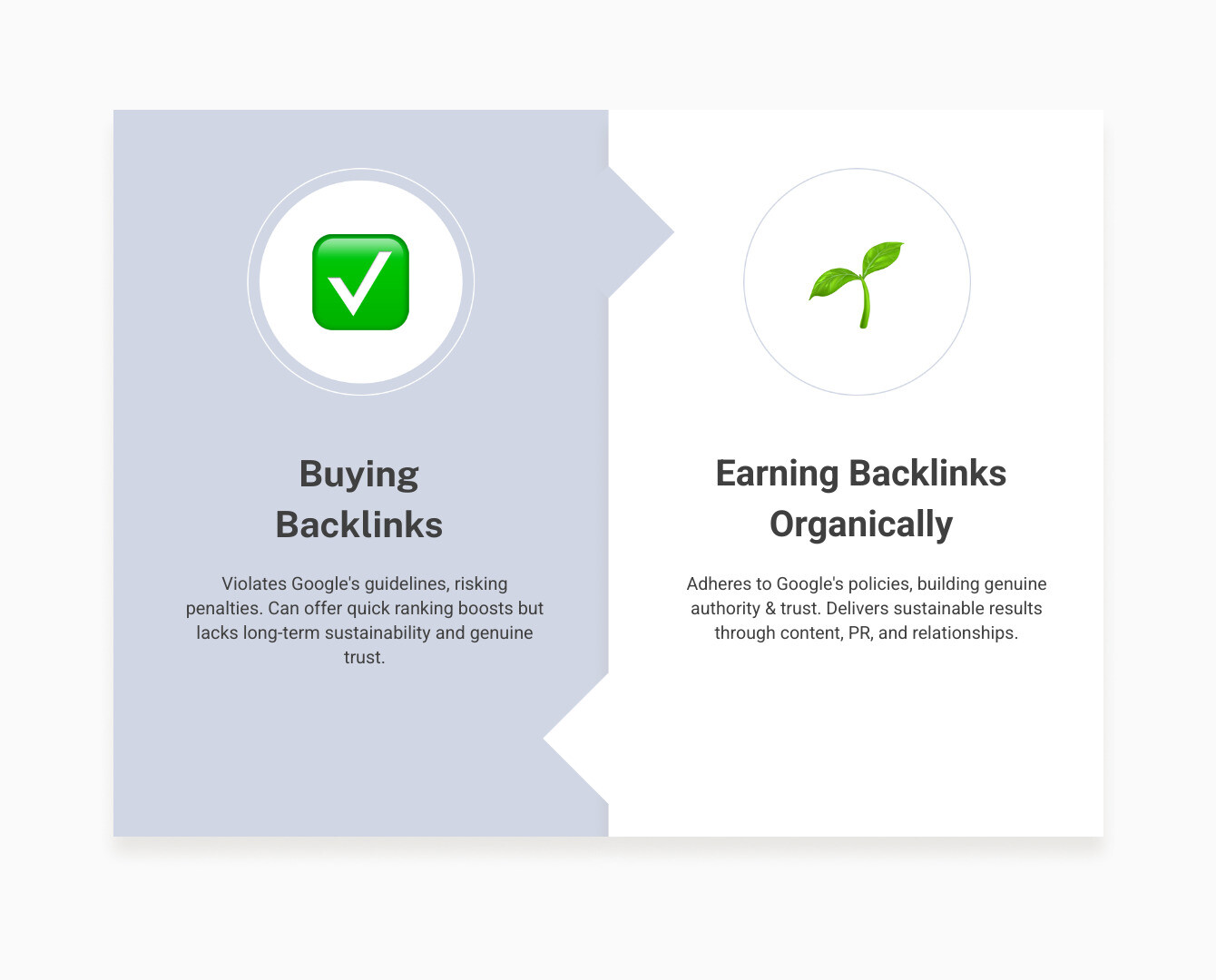Buy back links 2025: Smart & Safe Guide
What You Need to Know About Buying Backlinks
Buy back links is a tempting practice for businesses struggling with low search rankings. But is it the right move for you?
Quick Answer: Should You Buy Backlinks?
| Scenario | Recommendation |
|---|---|
| Low-Quality Links (PBNs, link farms, bulk packages under $50) | Avoid completely – High risk of Google penalties |
| Premium Editorial Placements (Guest posts on real, relevant sites) | Proceed with extreme caution – Still violates Google guidelines but lower risk |
| Organic Link Building (Digital PR, content marketing, relationships) | Recommended – Safest long-term strategy |
Backlinks—links from other websites to yours—are a crucial SEO ranking factor, signaling your site’s authority and trustworthiness. The problem? Google explicitly prohibits buying or selling links that pass ranking value, classifying it as a link scheme under its spam policies.
Despite this, the practice is common. One study found that 92% of SEOs believe their competitors buy links. This creates a gray area for businesses facing intense pressure to compete. The question isn’t just whether to buy backlinks, but how to evaluate the risks and rewards for your specific situation.
This guide will help you understand the risks, differentiate dangerous schemes from safer placements, and explore proven alternatives that won’t jeopardize your site.

Basic buy back links terms:
The Great Debate: Google’s Stance vs. SEO Reality
Google’s position on buying backlinks is clear: don’t do it. Their Spam Policies for Google Search state that buying or selling links for ranking purposes is a link scheme. The consequences range from having your links devalued (passing zero SEO benefit) to a manual action that could tank your rankings or even de-index your site.
Despite this, buying links is common in the SEO world. Why risk it? The answer lies in the harsh realities of competitive SEO. Building links organically is slow, especially for new sites or those in cutthroat niches. When competitors seem to be climbing the rankings at lightning speed, the temptation to buy back links as a shortcut becomes powerful. For those looking to build quality backlinks through safer methods, MDM Marketing’s guide on Insights on How to Build Quality Backlinks for SEO Growth offers valuable strategies.
How Google Detects Paid Links
Google’s detection methods are sophisticated, led by SpamBrain, an AI-based system designed to identify and neutralize unnatural link patterns. When SpamBrain finds suspicious links, it typically responds in one of two ways:
- Devaluation: The most common outcome. Google simply ignores the manipulative links, stripping them of any ranking value. You don’t get a penalty, but you’ve wasted your money.
- Manual Action: In more serious cases, Google issues a manual penalty that can cause your rankings to plummet. Recovery is a long and painful process.
Google also identifies link-selling footprints, such as sites that openly advertise link prices or appear on known link-selling databases.
Are Your Competitors Buying Links?
If you suspect your competitors are buying backlinks, you’re probably right. According to one study, a staggering 92% of SEOs believe their competitors are buying links. This creates a domino effect, pressuring others to follow suit.
However, blindly copying competitors is a poor strategy. They might be wasting money on devalued links or be one algorithm update away from a penalty. Instead of imitating, analyze their backlink profiles using SEO analysis tools. Look for red flags like sudden link spikes, links from irrelevant sites, or keyword-stuffed anchor text.
Success in SEO comes from making informed decisions about risk and building a sustainable backlink profile that can withstand Google’s scrutiny, not from matching competitors link-for-link.
The Spectrum of Paid Links: From Risky Schemes to Premium Placements
Not all paid links are the same. The practice exists on a spectrum, from dangerous schemes that can destroy your rankings to high-quality placements that carry less (but still some) risk. Understanding this difference is crucial.
| Factor | Low-Quality Link Schemes (e.g., PBNs, link farms) | Premium Editorial Placements (e.g., paid guest posts, niche edits) |
|---|---|---|
| Source | Artificial, irrelevant, low-authority sites | Real, relevant, high-authority websites |
| Cost | Very low (often $2-$20 per link) | Moderate to high (hundreds to thousands of dollars per link) |
| Risk | Extremely High (Google penalty or devaluation) | Moderate (still violates guidelines, but less detectable) |
| SEO Value | Minimal to negative | Potentially high (if executed carefully) |
| Appearance | Unnatural, keyword-stuffed, often in footers | Natural, contextual, within high-quality content |
Low-Quality Schemes to Avoid
These tactics give link buying its bad reputation. They are digital spam, and Google is excellent at spotting them. Avoid these at all costs:
- Private Blog Networks (PBNs): Networks of websites created solely to sell links. As one Redditor noted, they were a “great grift” until Google’s algorithms caught up.
- Link Farms: Interconnected sites that exist only to pass link juice. Google’s SpamBrain AI easily spots these patterns.
- Spammy Directories & Comment Links: Outdated tactics that haven’t worked in over a decade.
- Low-Cost, High-Volume Packages: Offers like “500 backlinks for $5” are a huge red flag. These links are worthless at best and harmful at worst.
High-Quality Investments: Editorial Placements & Niche Edits
On the other end of the spectrum are methods that mimic natural link building by focusing on quality and relevance.
- Paid Guest Posts: This involves paying a real, reputable website to publish a high-quality article that includes a link to your site. The content must be valuable to the host site’s audience to appear natural.
- Niche Edits (Link Insertions): Instead of creating a new post, you pay to have your link inserted into a relevant, existing article. Success depends on how well the link fits into the content.
- Sponsored Content: This is a transparent transaction where content is marked as sponsored. The link should use a
rel='sponsored'orrel='nofollow'tag, meaning it won’t pass ranking value but can still drive traffic and build brand awareness.
A contextual link building service focused on genuine editorial relationships can provide more sustainable benefits. While even premium placements violate Google’s guidelines if intended to manipulate rankings, the risk is significantly lower than with spammy schemes.
How to Safely Buy Back Links and Vet Potential Placements
If you explore paid link placements, careful navigation is essential. The goal is to make every link blend seamlessly into a natural-looking backlink profile. The vetting process is your insurance policy against penalties.

Key Metrics for Evaluating a Link Source
Before paying for a link, investigate the source site thoroughly:
- Topical Relevance: This is the most important factor. A link from an unrelated site is a major red flag for Google.
- Organic Traffic: Use SEO analysis tools to check if the site has real visitors. A site with high authority metrics but no traffic is likely a PBN.
- Domain Authority/Rating Metrics: Use domain authority or rating metrics as quick indicators of a site’s strength, but always prioritize relevance.
- Content Quality: Browse the site. Is the content well-written, original, and valuable? A site that exists only to sell links will feel hollow.
- Outbound Link Quality: Check who else they link to. A portfolio of questionable or unrelated domains is a sign of a link seller.
Common Red Flags When You Buy Back Links

Avoid sites with these warning signs:
- Public Price Lists: A “Write for Us” page that openly lists prices for links is a clear sign of a link-selling business.
- Poor AI-Generated Content: Generic, low-quality content is a massive red flag. Use AI content detection tools to verify.
- Too Many Unrelated Topics: A site covering everything from law to pet grooming is likely a content farm built for link buyers.
- Over-Optimized Anchor Text: A high concentration of exact-match keyword anchors in outbound links is a clear manipulation tactic.
How to Ensure You Buy Back Links That Appear Natural
The key to avoiding penalties is to make paid links indistinguishable from organic ones. Your anchor text strategy should be diverse, using your brand name, naked URLs, generic phrases (“click here”), and some partial-match keywords. Place links within the main body of relevant content, not in footers or sidebars. Maintain a slow, steady acquisition rate to mimic natural growth, and diversify your link sources to create a profile that looks earned, not manufactured.
The Economics of Paid Links: Costs, Benefits, and Measuring ROI
When you buy back links, you’re making a financial decision. For new websites or businesses in crowded markets, a strategic investment in quality backlinks can solve the chicken-and-egg problem: you need links to rank, but you need to rank to earn links. This can accelerate your timeline from invisible to credible.
Quality backlinks can drive referral traffic, improve search rankings for competitive keywords, and save you months or even years of slow organic growth. You can learn more about strategic approaches in our guide on Buy Backlinks Online.
The Cost of High-Quality Backlinks in 2025
Quality backlinks are not cheap. Forget the “$5 for 100 links” scams. We’re talking about legitimate editorial placements on real, authoritative websites.
In 2025, a single high-quality backlink often costs $1,500 or more. Placements on reputable news sites with strong domain authority can range from $1,500 to $2,500 per link.
Prices are driven by the site’s domain authority or rating metrics, its volume of organic traffic, and its topical relevance. Highly competitive or specialized niches also command higher prices. While some services offer placements starting around $350, premium managed campaigns will cost significantly more.
Measuring the ROI of Your Link Building
Spending thousands on backlinks only makes sense if you can measure the return. Here’s what to track:
- Keyword Rankings: Monitor your target keywords to see if they climb in search results over the weeks and months following link acquisition.
- Organic Traffic Growth: Check if the pages you’re building links to are receiving more visitors from search engines.
- Referral Traffic: A good backlink should send actual readers to your site. Analyze your referral sources in your analytics platform.
- Conversions: You want more leads and sales. Track conversion rates to see the real business impact of your investment.
Isolating the ROI of backlinks can be tricky since SEO is holistic. However, by tracking these key metrics over time, you’ll get a clear sense of whether your investment in buy back links is paying off.
Smarter Alternatives: Earning High-Quality Links Organically
While you can buy back links with caution, earning them organically is the safest, most sustainable strategy for long-term SEO success. Earned links build authentic authority that Google rewards and that won’t disappear with the next algorithm update.
For a comprehensive look at future-proofing your link strategy, explore our guide on Link Building 2025.

Digital PR and Link-Worthy Content
Digital PR involves creating newsworthy content and pitching it to journalists and bloggers to earn editorial links. While a campaign can cost $5,000-$15,000, it’s often more cost-effective than buying links long-term, and the results are 100% penalty-proof.
Create content that people want to reference:
- Data Studies & Original Research: Unique data is a link magnet. Smart Asset’s “Where Millennials Are Moving” study earned over 150 linking domains.
- Interactive Tools & Visuals: Fun, useful content gets shared widely. Just Park’s Reaction Time Test game attracted over 1,500 linking domains.
- In-Depth Guides: Becoming the definitive resource on a topic naturally earns links as others reference your work.
Relationship-Based Link Building
Building genuine relationships in your industry creates organic link opportunities that money can’t buy.
- Guest Posting for Authority: Instead of paying, offer to write exceptional content for a relevant, authoritative site. They get quality content, and you get exposure and a natural backlink.
- Expert Quotes: Use platforms like HARO (Help-A-Reporter-Out), Source of Sources, and Qwoted to provide quotes to journalists. This is a fast way to earn high-authority links.
- Networking & Collaboration: Engage with others in your industry online and at events. These relationships naturally lead to mentions and links.
Organic link building compounds over time. It requires patience, but it creates a resilient backlink profile that supports long-term growth.
Frequently Asked Questions about Buying Backlinks
What’s the difference between buying cheap links and investing in premium placements?
Cheap links (often sold in bulk) come from low-quality PBNs or link farms. They carry an enormous risk of Google penalties or devaluation and offer little to no SEO value. You’re essentially paying for spam.
Premium editorial placements involve paying for content on a legitimate, high-authority website with real traffic and topical relevance. While still against Google’s guidelines, the risk is significantly lower because the link appears natural and provides value to readers.
How can I tell if my competitors are buying links?
Analyze their backlink profile with an SEO analysis tool and look for these red flags:
- A sudden, unnatural spike in new backlinks.
- A large number of links from low-quality or irrelevant websites.
- Over-optimized anchor text that heavily uses exact-match keywords.
- Links coming from sites with obvious “Write for Us” pages that list prices.
Just because they’re doing it doesn’t mean it’s working or that you should copy them. They could be one algorithm update away from disaster.
Is it ever 100% safe to buy backlinks?
No. It is never 100% safe to buy back links for the purpose of manipulating search rankings. Google’s link scheme guidelines explicitly prohibit it.
However, the level of risk varies dramatically. Buying a cheap link from a PBN is like begging for a penalty. Investing in a carefully vetted editorial placement on a high-quality, relevant site is far less likely to be detected, but the risk is never zero. Google’s SpamBrain AI is constantly evolving.
The only truly safe, long-term strategy is earning links organically through high-quality content, digital PR, and relationship building.
Conclusion: Making the Right Choice for Your SEO Strategy
So, should you buy back links? The answer isn’t a simple yes or no. It’s a strategic decision that requires weighing significant risks against potential rewards.
While Google’s rules are clear, the competitive pressure is real. The most important takeaway is that not all paid links are created equal. A world of difference separates a sketchy PBN from a vetted editorial placement on a reputable site.
Your goal should be to build a backlink profile that is both powerful and sustainable. Every link should come from an authoritative, relevant source and appear natural. Whether you pursue premium placements with extreme caution or focus entirely on organic methods, this principle remains the same.
At MDM Marketing, based in North Canton, OH, we guide businesses through these murky waters with data-driven SEO strategies that prioritize long-term growth. We combine technical expertise with compelling content to build visibility that lasts, creating solutions that won’t put your site at risk.
The smartest strategy is a balanced one. If you consider paid placements, vet every source carefully. But never lose sight of the safest path forward: earning links through valuable content, digital PR, and genuine relationships.
Your backlink profile is the foundation of your online authority. Build it wisely. For expert guidance on creating a resilient link-building strategy and Mastering Effective Web Marketing Strategies for Modern Needs, explore our outsourced SEO services. We’re here to help you make the right choice.
About The SEO Experts at MDM Marketing
This author hasn't written a bio yet.
